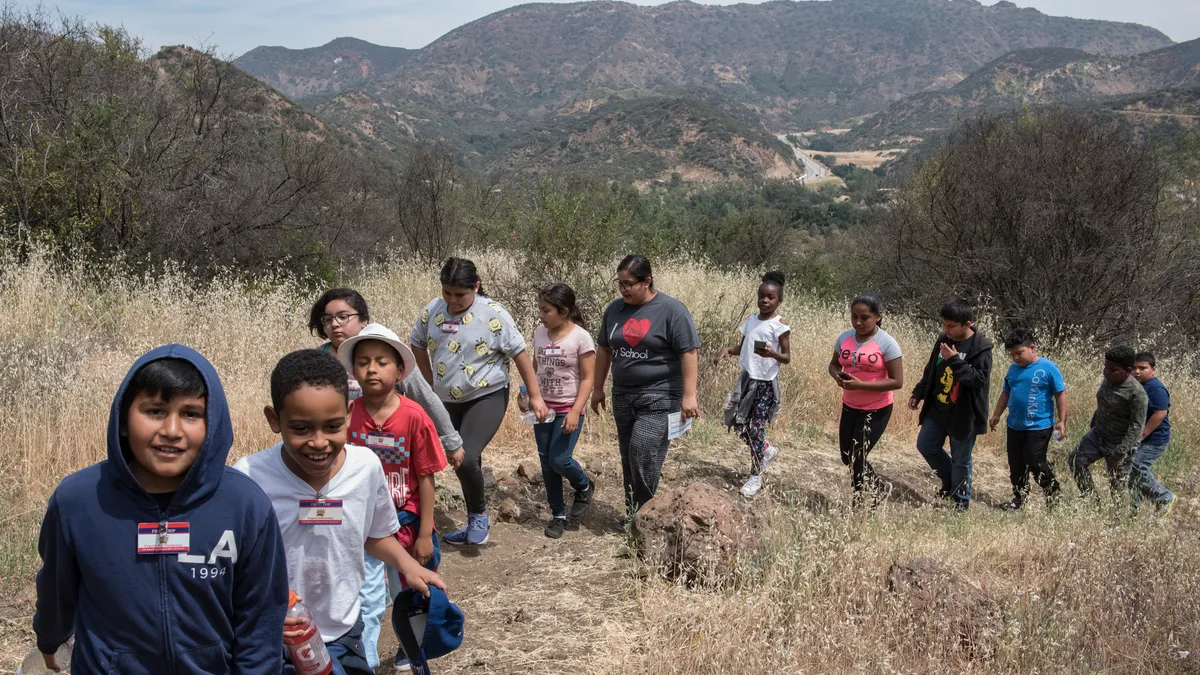Studying state history in a classroom can be a bit boring for 4th-graders, but field trips to state parks bring the past to life while connecting kids to nearby nature. Though close in proximity for most, national parks remain out-of-reach for many low-income families due to lack of transportation and funds.
The National Park Foundation helps bridge that equity gap. Since 2011, the foundation invested nearly $14 million in fields trips for more than one million students — mainly from Title I schools. In 2020, NPF hopes to connect another 250,000 students and adults to the parks, though current stay-at-home orders may prevent the foundation from reaching that goal this year.
“Accessibility is a limiting factor for so many students, especially those who come from underserved communities,” said Kim Bott, a California State Parks Aide who partners with Santa Monica Mountains National Recreation Area to coordinate the Open OutDoors for Kids program in the Los Angeles area.
Bott says it’s a magical moment when students first see the green spaces that are so close to their homes. Many parks feature historical landmarks that pay tribute to figures from state history.
“Every time the kids see a squirrel or bunny, they get really excited,” Bott said. “Recently on a hike, we saw a baby bunny off to the side of the trail and the students were so quiet you could hear a pin drop.”
Tying in with California’s state history, students can tour the home of the last governor of Mexico-ruled California, Pîo Pico. “This is such a great opportunity for students to see history in real life,” Bott said. “Students can walk through his home, see artifacts and play games that relate to that time period.”
There are also replicas of Native American teepees made with resources that still exist on site, such as tule, cattails, trees and yucca.
Vickie Garza, a teacher at Calahan Street Elementary School in Los Angeles, builds her curriculum around the Open OutDoors for Kids program and brings her students to the Santa Monica Mountains National Recreation Area, which is the closest park to her school.
“Getting kids out of the urban environment and into a wildlife setting is very important to us,” Garza said.
The Title I school has an outdoor space with chickens, a greenhouse and a habitat that allows educators to bring outdoor education to students, she said. The goal is to empower students to become citizen scientists so they will advocate for open spaces.
“We have the largest urban park in the U.S., Santa Monica Mountains National Recreation Area, located right in our backyard,” Garza said. “Yet many of our students come from lower-income communities that face barriers to park access. They would never have visited it unless they had an opportunity to get into the park through their school.”
Park visits help students connect what they learn in the classroom to experiences in nature.
“When students see a bird they’ve never seen before, or when they touch a unique type of plant, it brings the lessons in the classroom to life for them,” she said. “It’s so much more meaningful for my students than it would be had they read about the park in a book, or seen it in a movie. It’s beautiful to see as a teacher.”
Bott said ranger-led programs with built-in school curriculum and free transportation are impactful.
“The sooner we can get young kids into these parks, the better,” Bott said. “We want to instill a lifetime of passion for these parks as early in these students’ lives as we can.”
While getting students into the parks is important, the parks also provide online resources that can be used all the time in curriculum, Garza said.
“I’ve had a relationship with the parks for over 30 years,” she said. “There is such a wealth of resources that I use.”
Will Shafroth, National Park Foundation president and CEO, said national parks are “vibrant, living laboratories.”
“We know that being outside supports intellectual behavior,” Shafroth said.
Shafroth said the program targets 4th-graders because research shows they are influential when it comes to driving family behavior. “Families go on trips together, and if you get families to go to the park then you’ve won the battle by building future park champions,” he said.
Every 4th-grader can get a national park pass that will get allow them to visit parks for free with their families.
The foundation supports students around the country. Students who visit parks get to experience everything from historical re-enactments to beaches with interesting tide and dune systems.
“Our desire is to create a continuum of engagement,” he said. “Then, in high school, students can become citizen scientists and perhaps work with a conservation corps group.”
Though the parks have long sought ways to be more accessible to those at home, the service is using its current downtime due to coronavirus to implement more virtual experience initiatives with webcams, as well as more written content. For example, Yellowstone National Park has webcams set up at its geysers, including Old Faithful. It also includes a regularly updated blog and Zoom background photos.
Students can’t always get on a bus and visit a park, and it's even more challenging now, Shafroth said. But by pooling existing resources and launching new platforms, such as a Facebook page, the parks can continue to connect with them while they are stuck at home.
"We have tried to put our resources out there in a more accessible way," he said. "We are pivoting to find a new normal. People will be drawing more from virtual experiences."
At a more local level, state parks are harnessing existing resources and repurposing them into online content as well, Bott said.
"A lot of work on that is happening right now," she said. "California State Parks is putting a lot of resources out there that can be used for distance learning."






 Dive Awards
Dive Awards













